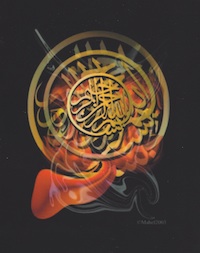
Pattern as Cosmology in Islamic Geometric Art
General Introduction
Pythagoras believed that theoria (contemplation) led to kosmos (here an orderliness in Life), thence to catharsis (the purification of the Soul), so that by Universal Reason we can proceed from gross matter upward to the Soul of the Universe, and thence to the Divine, or God.
The emphasis of Muslim thinkers on the nature of unity, that is, God, contributed to their adoption of the Pythagorean metaphysics of number, insofar as this doctrine, like early Neo-Platonism, reserved for the One a preeminent status as the apogee of all knowable reality.
The metaphysics of number, with the advent of modern science (which rendered obsolete the polyhedra that Plato thought the key to the universe), would have been forgotten, had it not been for the tenth-century Brethren of Purity, who continued to worship Pythagoras.
Their 52 Epistles argued, with him, that mathematics leads to moral edification as well as to intellectual insight, that it serves as a clue to knowledge of the self, which, in the classical Greek view, is the pathway to the highest knowledge, that is, to the knowledge of God.
To the Muslim it little matters that many details of Pythagorean numerology are no longer credible: that we no longer believe in the four elements, the four primary qualities, the four humors. He still believes that the Soul exists and that Universal Reason leads to God.
The second epistle deals with geometry, the sixth with “numerical geometric and harmonic ratios.” The substance of the heavenly bodies is elsewhere described as a “fifth nature,” a quintessence, setting them apart from other entities tied to generation and corruption.
Seven heavenly bodies are divested of gravity, because, created, by God, from the beginning (as were the seven stages of the Sentence, by MM) they still cling to their places, whereas objects with gravity have been forced out of their natural places and are seeking to rejoin them.
As important as reconciling mythic mathematics and modern science is belief in the doctrine that knowledge of the world must begin with knowledge of the self, that it is prior to any other knowledge, that the Muslim believer must know himself before he knows the outside world.
Of the four bodies of knowledge: mathematical, physical, psychological-intellectual and theological-juridical, the third is crucial. Psychology thus becomes for the Brethren the prelude to metaphysics and cosmology (an inner as well as outer science) and thus to all learning.
(Heavily indebted to Majid Fakhry, A History of Islamic Philosophy [New York: Columbia U. P., 2004], Chapter Five, “Neo-Pythagoreanism and the Popularization of the Philosophical Sciences”)
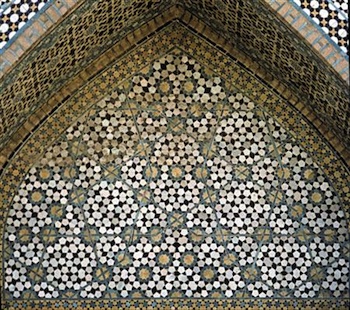
How do we get from the decorative to the cosmological? Yasser Tabbaa suggests an answer in his otherwise strictly historical study, The Transformation of Islamic Art during the Sunni Period (London: U. of Washington P., 2001). A highly empirical chapter on muqarnas [honey comb] vaulting and ash’ari occasionalism raises “the question of meaning in the muqarnas,” noting that “it has led to quite polarized interpretations, ranging from the usual fanciful readings by essentialist scholars to the rejections or ambivalent views of most art historians.” He cites Terry A. Allen as an example of positivist methodology, when Allen proposes that “geometric ornament and muqarnas are primarily visual inventions rather than intellectual constructs.” Oleg Grabar he cites to the contrary as holding that muqarnas was a neutral form “whose only purpose was to please.” Why the emphasis on pleasure?
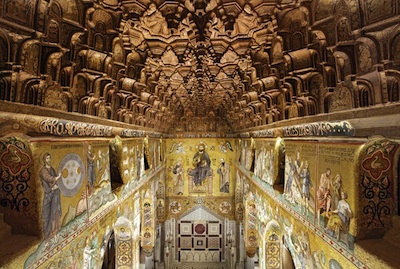
Earlier Tabbaa had quoted Philagathos’s description of his own experience of viewing the muqarnas ceiling of the tenth century Cappella Palatina in Palermo:
You do not tire of contemplating the roof [i.e., the ceiling], a cause of wonder and marvel to those who see or hear about it. Embellished as it is with delicate carvings, which are executed as differently shaped coffers and shining with gold from all sides, it imitates the clear sky of heaven, illuminated with gold from all sides.
The writer’s observation, says Tabbaa, “has to do with the effect and allusive power of a sustained meditation. . . . Joy, ‘insatiable enjoyment,’ is certainly the primary effect, and it is directly included in viewers who observe the exquisite geometric surfaces of the domes. For more informed viewers, this immediate enjoyment leads to wonder, marvel and astonishment [my emphasis].” Returning to Philagathos, Tabbaa says: “These muqarnas vaults produce the effect of ‘a heaven-like ceiling . . . a rainbow more colorful than the one in the cloud, and the clear sky of heaven illuminated by the choir of the stars. In sum, the effect proceeds from instant joy to wonder to heavenly allusion [i.e., cosmology].”
Cosmology always represents a leap of faith, is always metaphorical to one degree or another. The cosmos cannot be represented in purely mathematical terms: Pythagoreanism is a distant approximation of a universe assumed to be knowable. The modern cosmologist must admit to much greater uncertainty. Take the question (to go no further) of “dark matter,” postulated, necessary for our theoretical cosmology to pan out, but as yet not proven to exist, its effects only perhaps observable, the substance itself out of reach.* So it is that we leap from the page of mathematical calculations, from the telescope of observation, to the heaven of certainty. Implicit in the very subject of cosmology, which itself is a tension between observable and theoretical.**
*With Superstring Theory we must invent the mathematics as we go along, unnerved by the realization that the reality may never otherwise manifest itself.
**The analogy in Sentence of the Gods is between in situ observation and the gods; individual books, with their observation of the actual world, and the larger sequences into which the books are organized, according to the major gods that correspond to the days of the week.
*
“The view that geometrical shapes and propositions express profound truths about the nature of the universe was put forward by Pythagoras (c. 550-500 BC). ‘Justice is number four’ was one of the sayings of his disciples, for they held that all abstract concepts were really expressions of number and, to take another example, ten was the number of the universe. The mathematical and ultimately harmonious nature of the universe was confirmed by experiments with a single-stringed lute. First one plucked the string to produce a note. Then he halved the string to produce a note that sounded an octave higher. Then the same string was divided in the ratio three to two and this produced a note that was a fifth higher. The ratio four to three gave a note that was a fourth higher. These things were mysteriously meant.”
“Majriti was responsible for introducing an Islamic-Arabic version of Pythagoreanism into Muslim Spain in the Rasa’il (the ‘Letters’) of the Ikhwan al-Safa. The Brethren of Purity were a secretive intellectual brotherhood who did their research and wrote probably in tenth- or eleventh-century Basra. Their Rasa’il constituted an encyclopedia of all the sciences, with spiritual overtones, as its authors believed in salvation through the mastery of the sciences. It consisted of 26 letters or treatises, the first of which was on number, the second on geometry and the third on astronomy. According to the Brethren, ‘the science of numbers is the root of other sciences, the fount of wisdom, the starting point of all knowledge, and the origin of all concepts.’ In their Pythagorean thinking, the number one was the cause of all the other numbers.”
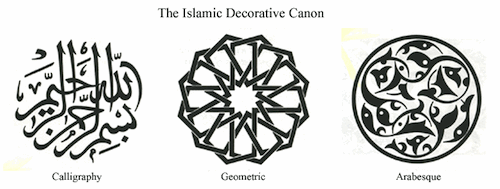
Tabbaa, in his final chapter, “The Mediation of Symbolic Forms,” summarizes his argument:
I have . . . argued that two central tenets of the new theology — the uncreated and exoteric nature of the Qur’an and the occasionalistic view of the universe — bore directly on the transformation of the most important features of Islamic art, including qur’anic calligraphy, public inscriptions, vegetal and geometric ornament, and muqarnas vaulting. Specifically, I have proposed that the ash’ari view concerning the eternity of the Qur’an and the exoteric (zahiri) nature of the word of God directly contributed to the application of more legible cursive scripts to the Qur’an and the proliferation of these scripts in public inscriptions. I have also argued that the widespread acceptance of occasionalism among the theologians of the eleventh century would have contributed to the creation and proliferation of arabesque ornament, particularly in its most distilled and potent form, the muqarnas dome.
Some have postulated “internationalization” as a cause for a new uniformity in the move from naturalistic to abstract art. Says Tabbaa, “[I]t is no longer possible to offer either essentialist arguments for the transformations of calligraphic and architectural forms in medieval Islam as direct emanations from a central, all-encompassing dogma or system of representation, or positivist explanations for them as ‘natural developments’ from early or pre-Islamic art. Here he cites a scholarly work by Gulru Necipoglu (1995):
It was not visual similarity, but difference, that communicated contested religio-political ideologies within the extensive Muslim domains whose internal boundaries were marked by constantly shifting abstract sign systems capable of conveying semiotic messages to insiders who were familiar with culturally determined codes. Despite their apparent unity, these visual signs hardly constituted a homogeneous “Islamic” style with fixed horizons; discontinuities and ruptures resulted in a lively spectrum of competing paradigms.
On the general significance of Islamic abstraction Tabbaa concludes:
Geometric ornament has been seen to have a spiritual dimension, as a reflection of the order of the universe and a concretization of its atomistic composition and occasionalistic structure. Geometric ornament and stereotomic design also possessed an allegorical dimension that links the splendor of human efforts with the wonders of God’s creations. Finally, geometry could fulfill a didactic function by focusing the minds of worshipers on central issues of dogma and “clearing error from one’s mind. . . . Neither pan-Islamic nor specific to one dynasty, race or geographic region, these calligraphic and ornamental forms cannot be ascribed to an Islamic essence nor to the genius of one particular racial or linguistic group, whether Turkish, Persian or Arab. They were, rather, produced within specific religio-political, social and technological contexts . . .”
Munir ul Haq Hassani, my Pakistani tutor, comments on Tabbaa as follows:
“The universe belongs to human beings”
“What we see is because of us”
“God created the universe for this purpose”
“There must, however, be a power Who controls the universe, and thus the necessity of God's continuation after its creation.”
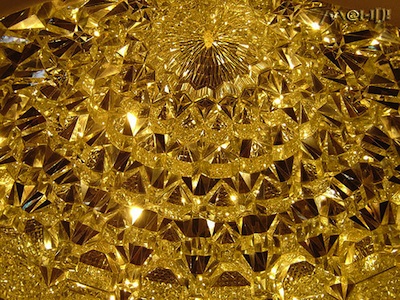
Tabbaa studies at some length the muqarnas dome, a feature of highly developed Islamic architecture but one that did not last for very long, historically. This raises many questions, which I posed to Mr. Hassan: He said that he saw the dome in relation to Islamic theology; that it “attracts all the good things and enables us to follow therefrom the path to God.” “Why did the dome arise as a form?” “From the Islamic point of view the skies are the blue dome that we see during the daytime, a solid structure perfectly designed by the hand of Allah, with no cracks. The sky stands stable above the earth, probably supported by invisible pillars. If it were not for Allah’s mercy, it would certainly fall to earth, killing every one of us. According to a particular teaching,” he added, “it corresponds to the completion of a line of theological thought. It represents the resolution of problems in theology, in architecture, in Islamic life. It is a modernization. Therefore it is typical of the best of theology and artistic practice.”
I had also sent Hassan my re-written quotations from Hillenbrand [see section 4E], those that comprise a sketch of the growth of abstraction in Islamic art. Hassan spoke of “the creation of abstraction.” I asked why abstraction comes and goes in the history of Islamic art. “It occurs,” he said, “after moments of consummation. But the theme of cosmology and the technique of abstraction,” he added, “are constants in the historical continuum. The growth of tolerance in Islamic ethics reinforces abstraction,” he noted. “Abstract Islamic art evolves so as to express feelings, those formerly known,” he observed, “only in naturalistic art.”
*
More quotations from Yasser Tabbaa, The Transformation of Islamic Art During the Sunni Revival (London: U. of Washington P., 2001), concerned mostly with the muqarnas dome, but also with the nature of the Islamic “ocasionalistic” cosmology:
Muslim philosophers and theologians devoted considerable thought to the nature of matter and the universe and their relationship to God. Even the most rationalist Muslim theologians rejected the Aristotelian concept of an eternal cosmos, because it contradicted the Islamic conception of God as the only absolute and eternal. . . .
The Ash’aris of the tenth and eleventh centuries took over this atomistic cosmology and pushed it to its natural extremes, making it a cosmology of occasionalism, or a theory of atoms and accidents. Abu Bakr al-Baqillani (d. 1013), the chief Ash’ari theologian before al-Ghazzali, argued that the world, which to him was everything other than God, was composed of atoms and accidents. Accidents could not endure within matter (jawhar) for longer than an instant, but were continuously being changed by God. It follows, then, that the attributes of matter (color, luminosity, shape, etc.) are transitory accidents that change according to the will of God, and that even the preservation of matter — the collocation of its atoms — requires the continuous intervention of God.
The occasionalism of al-Baqillant therefore ascribed to God not only the first act of creation but also the unending process of preserving the created world from one instant to another. Through a continuous process of annihilation and recreation, God alone can guarantee the order and consistency of the universe by preserving the accidental combination of atoms. This cosmology embodied the wisdom and knowledge of an omnipotent God, who had directly created the universe in time and without any intermediaries, and who was continually involved in maintaining its order, balance and coherence. This theory differed from the Mu’tazili, Isma’ili and even Shi’i views of the universe, which, in varying degrees, held to the belief that the universe was an external emanation existing independently of God and subject to its own natural law. . . .
The parallels between occasionalistic cosmology and the muqarnas dome are very striking indeed, displaying on the macro and micro levels ideas of fragmentation, impermanence and imminent collapse. Indeed, the seemingly complete confluence between the attributes of occasionalism and the perceptual properties of the muqarnas dome was intended as an architectural manifestation of this thoroughly orthodox Islamic concept. In order to represent an occasionalist view of the world, a fragmented and ephemeral looking dome was created by applying muqarnas to its entire surface, from transition zone to apex. This procedure creates a comprehensive effect intended to reflect the fragmented, perishable and transient nature of the universe while alluding to the omnipotence and eternity of God, who can keep this dome from collapsing, just as he can keep the universe from destruction.
The likely origin of the muqarnas dome in Baghdad in the early eleventh century coincides with the triumph of Ash’ari thought and occasionalistic cosmology. More specifically, during the pivotal period of Caliph al-Qadir, his chief theologian and apologist, al-Baqillant wrote treatises and issued manifestos opposing Mu’tazili theology and Fatimid rule as well as valorizing Sunni traditionalism and Abbasid rule. . . .
Grabar does not base his interpretation of these magnificent domes on their form but rather on richly evocative poetic and prosodic texts, some of which are inscribed on the very walls supporting the domes. [Tabbaa quotes one such poem.] As with earlier Christian descriptions of muqarnas domes, this poem extols the celestial qualities and heavenly associations of the domes, whose various components have left their terrestrial tethering and joined the orbits of stars and constellations. As Grabar emphasizes, this description goes even farther, comparing the domes to the rotating dome of heaven, a concept dating back to classical antiquity but still resonating in medieval times. This brilliant interpretation is obviously specific to the domes of the Alhambra and can neither be projected backward onto earlier muqarnas domes nor be used to impute an absence of meaning to other domes that cannot sustain such an interpretation. Rather than undermining our Ash’ari reading of the muqarnas dome, Grabar's interpretation actually embellishes it by giving it a new dimension acquired in the intervening two or three centuries of development.
To summarize briefly, the muqarnas dome was created in an atmosphere of heightened religious dogmatism and intense political opposition to the Fatimids. Just like the proportioned scripts of Ibn Muqla, it was simultaneously intended to pay homage to the Abbasid caliphate and to embody the central cosmological tenets of the Sunni revival.
Despite its great ubiquity after the twelfth century it was not known in early Islamic architecture and not very significant in its later phases, but epitomized certain transformations that took place during its middle period. . . . The muqarnas dome, despite its sometimes astounding complexity, is in fact a closed and finite system, whose meaning lies not in allegorical narratives from a sacred text nor in images that provide a window onto another world, but in the intricacies of the form itself. It restricts perception to the immediately tangible universe and directs meditation toward an all-powerful God.
This morning from 10:00 o’clock to 11:30 I was fortunate that my Islamic informant, Mr. Hassan, had no customers at Omar Khayyam Restaurant in Pattaya’s Soi 16 (which soi, incidentally, is the site of the photos that I had taken some years ago for a Flickr display of mine whose first photo is titled “Arabia.” One may also access these by clicking on “Photos” at the home page of MM’s Web). This session focused upon triangular relations, among them:
A. The Sun, the Earth and the Moon

B. The Earth in motion about the Sun, the Moon about the Earth

C. Allah, Rahman and Rahim
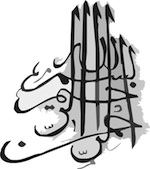
A. These are the three most important “planets” in Islamic thought
Their relationship is considered to be eternal; it is said that, if their relationship were to vary, Life would cease to exist. Here is perceived an analogy with the three elements in C.
The triangle expresses the relationships between
The Sun and the Moon, the Moon and the Sun
The Sun and the Earth, the Earth and the Sun
The Earth and the Moon, the Moon and the Earth
At the center of the triangle is Life (because Life exists as a result of the three planets, Sun, Moon and Earth)
B. The Earth’s circumambulation of the Sun expresses the Day, the Moon’s circumambulation of the Earth, the Night
The Moon can eclipse the light of the Sun for the Earth
C. At the center of the triangle of Allah, Rahman and Rahim is the Human. C. may be regarded as a religious allegory of A.
Therefore, it is said, the Human depends upon Allah, Rahman and Rahim
As the reader doubtless knows this is not a Christian “Trinity,” for “There is only one God, and his name is Allah.”
A complementary gloss from Critchlow on the triangle in Islam:
The triangle is the first polygon, the minimal expression of an area, and the simplest figure to which the other polygons can be reduced. It is also symbolic of the minimal requirements of consciousness (i.e., Knower, Known and the act of Knowing), as well as the minimal description of the basic biological needs: ingestion, absorption and excretion.
Mr. Hassan returned to the theme of the Koran’s universality: “It is not,” he said, “only for Islam, it is for the whole world.” According to the true believer, it predicts events (several examples were given). “Its power of prediction,” he said, “is related to the process of Renewal.”
Introduction in Arabic:
نموذج عن علم الكونيات في علم الهندسة الإسلامية
مقدمة:
اعتقد فيثاغورث أن التأمل كان الطريق الذي قاد إلى نظام الترتيب الكوني، ومن ثم إلى تنفيس العواطف (تطهير الذات). لذا بإمكاننا، وفقاً للقانون الكوني، الإرتقاء من الأمور الغريزية الفظة صعوداً باتجاه روح الكون وجوهره, ومن ثم إلى ماهو سماوي أو إلى الله.
إن تأكيد علماء ومفكري الإسلام على فكرة التوحيد، والتي تعني وحدانية الله، قد ساهم في تبنيهم فكرة ماورائيات الأرقام الفيثاغورية، حيث أن هذا المذهب، وكمذهب الأفلاطونية الجديدة السابق له، قد التزما بفكرة الوحدانية كحالة بارزة تربعت على عرش جميع المعارف البشرية.
إن علم ماورائيات الأرقام، ومع ظهور العلوم الحديثة (التي أعادت إلى المشهد نظرية متعددات الأوجه التي عفا عليها الزمن والتي اعتقد أفلاطون أنها مفتاح هذا الكون)، ربما كان مصيره الإندثار لولا ظهور أخوان الصفا في القرن العاشر الذين تابعوا تقديسهم لفيثاغورث.
تماماً كما جاء عند فيثاغورث، فإن إخوان الصفا في رسائلهم الإثنتين والخمسين قالوا بأن الرياضيات هي الطريق الذي يقود إلى التهذيب الأخلاقي والإستبصار الفكري. حيث أنها تعد بمثابة مفتاح لمعرفة الذات، بينما اعتبرها الإغريق طريقاً لأسمى مراتب المعرفة، ألا وهي معرفة الله.
بالنسبة للمسلمين، فإن التفاصيل العديدة لعلم الأرقام الفيثاغورثية ليست بتلك الأهمية، سيما وأنها لم تعد ذات مصداقية. أما بالنسبة لنا كغربيين، فإننا لم نعد نؤمن بالعناصر الأربعة ولا بالخصائص الأربعة أو حتى الأمزجة الأربع. بينما ظل المسلمون يعتقدون بوجود الروح على أنها السبب الكوني الذي يقود إلى الله.
تتطرق الرسالة الثانية من رسائل أخوان الصفا إلى مسألة علم الهندسة، بينما تتحدث الرسالة السادسة عن "علم هندسة الأرقام والنسب المتوافقة". كما يتم وصف جوهر الأجسام السماوية في مكان آخر من الرسائل بـ "الطبيعة الخامسة"، أي الجوهر الخامس. وبهذا تنأى هذه الأجسام عن غيرها من الموجودات الأخرى المرتبطة بالتكاثر والفساد.
سبعة أجساد سماوية تخرج عن سيطرة الجاذبية الأرضية، ذلك أن الله قد خلقها منذ البدء (وهي تشبه مراحل الحكم السبعة في كتاب ماديسون موريسن). فهذه الأجساد لاتزال معلقة بمكانها الأصل، بينما ظلت الموجودات الأخرى بسبب الجاذبية مجبرة على البقاء بأماكنها الطبيعية تتوق للإنضمام إلى الأجساد السماوية السبع.
كما لاتقل مسألة التوفيق بين الرياضيات الأسطورية والعلوم الحديثة أهمية عن الإيمان بالمذهب القائل: "معرفة العالم يجب أن تبدأ بمعرفة الذات أولاً"، وأن هذه المعرفة سابقة لأي معرفة أخرى. ومن هذا المنطلق توجب على المسلم المؤمن معرفة ذاته قبل معرفة العالم الخارجي المحيط به.
ومن أجزاء المعرفة الأربعة: المعرفة الرياضية والمعرفة الفيزيائية والمعرفة النفسية الفكرية والمعرفة العدلية اللاهوتية، يحتل الجزء الثالث من أجزاء المعرفة مرتبة بالغة الأهمية، حيث يُعتبر علم النفس بالنسبة لأخوان الصفا فاتحة إلى علم الماورائيات وعلم الكونيات ومنه إلى كل أنواع العلوم والمعارف (ويعد علم النفس من العلوم الداخلية والخارجية).
تأليف: ماديسون موريسون
ترجمة: عيسى المصطفى
(أدين بالشكر العميق لماجد فخري للإستعانة بكتابه: تاريخ الفلسفة الإسلامية، ]نيويورك: كولومبيا. يو. بي. 2004[، الفصل الخامس: الفيثاغورثية الحديثة ورواج العلوم الفلسفية)
trans. Issa al-Mustafa
